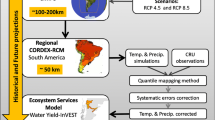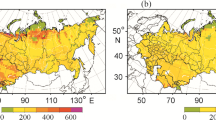Abstract
Possible climate changes in Russia during the 21st century are considered based on the INM-CM5-0 climate model. According to the SSP3-7.0 scenario, the warming by 5–8°C in winter and by 3–4.5°C in summer are expected in Russia at the end of the 21st century. Minimum annual temperatures will rise faster than winter mean ones. Maximum annual temperatures will rise faster that summer mean ones. An increase in precipitation will occur across Russia in winter, while its decrease is expected in southern and central European Russia and in the south of Western Siberia in summer. The contribution of light precipitation will decrease, while the contribution of heavy and very heavy precipitation will increase. An increase in annual mean river runoff and a decrease in upper soil moisture in summer are expected nearly everywhere in Russia.



Similar content being viewed by others
REFERENCES
P. N. Vargin, S. V. Kostrykin, and E. M. Volodin, “Analysis of Simulation of Stratosphere-troposphere Dynamical Coupling with the INM-CM5 Climate Model,” Meteorol. Gidrol., No. 11 (2018) [Russ. Meteorol. Hydrol., No. 11, 43 (2018)].
E. M. Volodin and A. S. Gritsun, “Simulation of Possible Future Climate Changes in the 21st Century in the INM-CM5 Climate Model,” Izv. Akad. Nauk, Fiz. Atmos. Okeana, No. 3, 56 (2020) [Izv., Atmos. Oceanic Phys., No. 3, 56 (2020)].
E. M. Volodin and S. V. Kostrykin, “The Aerosol Module in the INM RAS Climate Model,” Meteorol. Gidrol., No. 8 (2016) [Russ. Meteorol. Hydrol., No. 8, 41 (2016)].
E. M. Volodin and M. A. Tarasevich, “Simulation of Climate and Weather Extreme Indices with the INM-CM5 Climate Model,” Meteorol. Gidrol., No. 11 (2018) [Russ. Meteorol. Hydrol., No. 11, 43 (2018)].
B. I. Cook, J. S. Mankin, K. Marvel, A. P. Williams, J. E. Smerdon, and K. J. Anchukaitis, “Twenty-first Century Drought Projections in the CMIP6 Forcing Scenarios,” Earth’s Future, 8 (2020).
V. Eyring, S. Bony, G. A. Meehl, C. A. Senior, B. Stevens, R. J. Stouffer, and K. E. Taylor, “Overview of the Coupled Model Intercomparison Project Phase 6 (CMIP6) Experimental Design and Organization,” Geosci. Model Dev., 9 (2016).
C. Li, F. Zwiers, X. Zhang, G. Li, Y. Sun, and M. Wehner, “Changes of Daily Extremes of Daily Temperature and Precipitation in CMIP6 Models,” J. Climate, 34 (2021).
C. Tebaldi, K. Debeire, V. Eyring, E. Fischer, J. Fyfe, P. Friedlingstein, R. Knutti, J. Lowe, B. O’Neill, B. Sanderson, D. V. van Vuuren, K. Riahi, M. Meinshausen, Z. Nicholls, K. Tokarska, G. Hurtt, E. Kriegler, J. Lamarque, G. Meehl, R. Moss, S. Bauer, O. Boucher, V. Brovkin, Y. Byun, M. Dix, S. Gualdi, H. Guo, J. John, S. Kharin, Y. Kim, T. Koshiro, L. Ma, D. Olivie, S. Panickal, F. Qiao, X. Rong, N. Rosenbloom, M. Schupfner, R. Seferian, A. Sellar, T. Semmler, X. Shi, Z. Song, C. Steger, R. Stouffer, N. Swart, K. Tachiiri, Q. Tang, H. Tatebe, A. Voldoire, E. Volodin, K. Wyser, X. Xin, S. Yang, Y. Yu, and T. Ziehnet, “Climate Model Projections from the Scenario Model Intercomparison Project (ScenarioMIP) of CMIP6,” Earth Syst. Dyn., 12 (2021).
A. M. Ukkola, M. G. de Kauwe, M. L. Roderick, G. Abramowitz, and A. J. Pitman, “Robust Future Changes in Meteorological Drought in CMIP6 Projections Despite Uncertainty in Precipitation,” Geophys. Res. Lett., 46 (2020).
E. Volodin, “The Mechanisms of Cloudiness Evolution Responsible for Equilibrium Climate Sensitivity in Climate Model INM-CM4-8,” Geophys. Res. Lett., No. 24, 48 (2021).
E. M. Volodin, E. V. Mortikov, S. V. Kostrykin, V. Y. Galin, V. N. Lykossov, A. S. Gritsun, N. A. Diansky, A. V. Gusev, and N. G. Iakovlev, Simulation of the Present-day Climate with the Climate Model INMCM5,” Climate Dynamics, No. 11–12, 49 (2017).
M. D. Zelinka, T. A. Myers, D. T. McCoy, S. Po-Chedley, P. M. Caldwell, P. Ceppi, S. Klein, and K. Taylor, “Causes of Higher Climate Sensitivity in CMIP6 Models,” Geophys. Res. Lett., 47 (2020).
Author information
Authors and Affiliations
Corresponding author
Additional information
Translated from Meteorologiya i Gidrologiya, 2022, No. 5, pp. 5-13. https://doi.org/10.52002/0130-2906-2022-5-5-13.
About this article
Cite this article
Volodin, E.M. Possible Climate Change in Russia in the 21st Century Based on the INM-CM5-0 Climate Model. Russ. Meteorol. Hydrol. 47, 327–333 (2022). https://doi.org/10.3103/S1068373922050016
Received:
Revised:
Accepted:
Published:
Issue Date:
DOI: https://doi.org/10.3103/S1068373922050016




